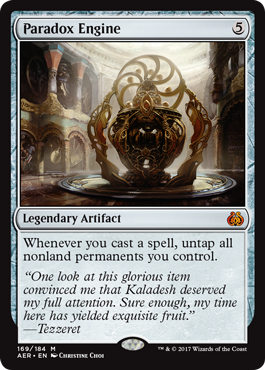Building Your Engine
Start your engines!
...But not quite like that.
No, today I mean a different kind of engine. One that has been a part of Magic since the game kicked off. When the earliest deck builders took their stonework deck-building tools and began mashing them together to see what worked, the first person to find these must have felt like mankind discovering fire(ball).
I'm talking about combo engines.
Today, we're going to look at individual cards that are combo engines: what they are, how to identify them, and how to use them to break the game and crush your opponents.
Oh, and along the way I'll show off a spicy new preview card from Aether Revolt.
Sound good? Well, let's get to it!
Finding a Combo Engine
Okay—so what does it mean to be a combo engine?
When talking about individual cards that are combo engines, people generally mean a card that you build around and around which you combination then revolves. Generally, to be an engine, the card is a permanent so it can stick around on the battlefield and continue revving you up somehow.
Whenever I see a card that's a combo engine, the gears in my head immediately start turning on how to make it work. And while sometimes it's pretty subtle or a combo engine in unanticipated ways, often the cards start out pretty well.
What are some things to look for? Well, if a card sits on the battlefield and has a unique effect, that's a good start. You can look for cards that repeatedly help you generate resources or effects in some way. A good engine will often help you do something over and over again.
Let's look at a few examples of combo engines.
Aetherworks Marvel both gives you energy and a big way to spend it. If it was merely a repeatable way to get energy it would still be an engine, but the second ability is so strong on its own that the card saw quite a bit of play at Pro Tour Kaladesh.
Here's an old-school engine piece that has done all kinds of busted things. Letting you untap your lands lets you easily generate mana with any lands that make multiple mana (like, say, Tolarian Academy) or if you just cheat this onto the battlefield at a reduced cost.
This is an engine that screams to be broken. Duplicating every enters-the-battlefield effect makes it pretty clear what to look for with this—and from there, it's just about finding the right ones.
This looks unassuming as a creature with a three-mana activated ability—but that it lets you reuse enters-the-battlefield abilities means the first things I'm going to look for are ways to generate mana upon entering the battlefield. And lo and behold, alongside Brood Monitor it lets you create endless enters-the-battlefield and dies triggers—which can easily be taken advantage of with something like Zulaport Cutthroat around.

This big artifact is one large perpetual motion machine, letting you—
Oh! I suppose you haven't seen this one before? Say hello to our Aether Revolt preview card!
Not only is it literally an engine, but it's certainly rife with combo-engine potential. It is a repeatable effect that lives on a permanent and can generates resources. It harkens back to the aforementioned Palinchron of old.
Let's break it, shall we?
Building with a Combo Engine
All right. So let's say you've chosen the combo-engine card you want to try to build around. Next, it's time to start figuring out what you're going to do with it!
In the case of Paradox Engine, what you need to figure out is how you're going to benefit from its effect. What are some things that you want to untap over and over again?
You could pick any number of things to do here. But I'm going to start with one that looks the most clear to me: mana abilities!

Paradox Engine doesn't untap your lands—that'd be a little too easy—but all your other mana producers are still fair game. Creatures and artifacts that make mana are now untapped when you cast a spell—which means if you just hit critical mass on them, you can easily make all your spells free or even have them provide you mana as you cast them!
This is the part where I would normally recommend you boot up Gatherer and run a search on things in Standard that make mana. But I've done the legwork and, indeed, there are plenty of good options: Cultivator's Caravan, Deathcap Cultivator, Hedron Archive, and even Corrupted Grafstone are all reasonable options.
So, one direction to go is to cram all of these together with the Engine to create your mana loop. Notably, if you're trying to combo off in one turn and cast an artifact accelerator like the Caravan, then it will up your mana production on every spell you cast since you can tap it right away!
Of course, you can always go deeper. Here's one pretty crazy card to try to pair with Paradox Engine:
Instead of playing a bunch of random artifacts, now you just need to go with a bunch of tokens and you're good to start comboing out.
Speaking of comboing out—no matter what method you pick, what are you actually doing with all this mana? How are you chaining spells together?
Sounds like a good time to move onto the next step!
Situational Engineering
Once you get your engine in place and identify how you're using it, there's still the big detail of figuring out what support pieces you need to make your combo work.
So, I'd start by asking the question: what does my combo need?
Well, we have a way to produce mana every time we cast spells. This means we are both generating mana and casting spells for free. So it sounds to me like what we need are more spells! After all, if we had our whole library in our hands we could cast everything.
That takes me right to card-drawing spells. If you cast a spell that draws you three cards while generating a net gain in mana, with enough card-drawing spells in your library you can chain one into another, netting mana on each until you've finally drawn your whole deck and have a ton of mana in your pool—in which case it's time for your finisher.
Might I recommend a combo finisher classic: the X spell?
You only need one or two copies since you're guaranteed to find it when drawing so many cards.
Now that you've got your combo engine down, your combo pieces understood, and your win condition in mind, it's time to build it up! You know you're going to need Paradox Engine, nonland mana sources, lots of card drawing, and a couple X spells to win with. Anywhere the two overlap—such as Hedron Archive—is definitely a nice bonus.
Getting the proportions right can take time—but you now have the shell of your Paradox Engine combo deck! Fill in the rest, and give it a spin!
Living in a Combo Nation
Hopefully you enjoyed your first look at Paradox Engine—and this look at building around a combo engine.
Every combo deck is different to build depending on the unique nature of the piece, but this scaffolding should help you get started on building whatever you need to. Go forth and combo out!
If you have any thoughts or comments on this article, I'd love to hear from you! You can always reach me by sending over a tweet, asking me a question on my Tumblr, or sending an email in English to BeyondBasicsMagic@gmail.com.
May all of your Paradoxes come true.

